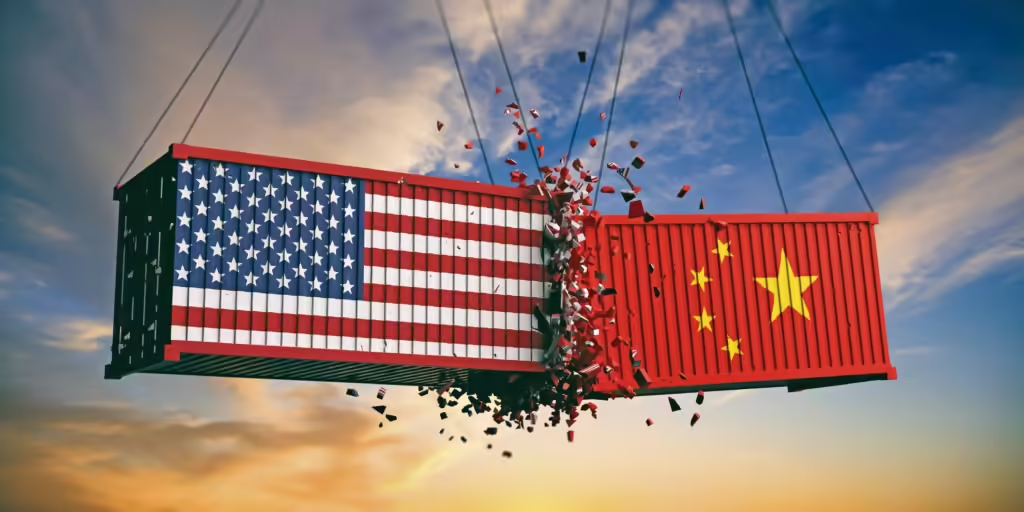
Trump’s Decision on Tariffs: A Shift in Trade Policy
Donald Trump’s decision to impose tariffs marked a significant shift in US trade policy. Initially, Trump proposed a 25% tariff on imports from Canada and Mexico, only to temporarily suspend it while negotiations continued. At the same time, he threatened to impose tariffs on the European Union, signaling an aggressive stance on global trade. As trade discussions unfolded, the China tariffs effect on US manufacturers became a central issue.
By raising tariffs, Trump aimed to reduce the trade deficit and encourage manufacturing within the United States. The strategy, however, placed a significant burden on US manufacturers, who were heavily reliant on Chinese imports for raw materials and components.
As tariffs increased, costs soared, leaving manufacturers in a precarious position, forced to either absorb the additional costs or raise prices for consumers. This, in turn, led to a direct impact on businesses across various sectors, highlighting the multifaceted China tariffs effect on US manufacturers.
| Key Points | Details | Impact |
|---|---|---|
| Trump’s Tariff Decision | Imposed tariffs on Canada, Mexico, and threatened EU. | Economic tension escalated. |
| Goal of Tariffs | Boost US manufacturing by making imports costlier. | Aimed to create jobs in the US. |
| China’s Retaliation | China imposed tariffs on US goods in return. | Escalated trade conflict. |
| Manufacturers’ Struggles | Increased costs on Chinese imports affected US firms. | Lower profit margins. |
| Consumer Impact | Prices rose due to higher tariffs. | Affected everyday products. |
| Economic Uncertainty | Uncertainty in trade relationships. | Slowed down business operations. |
Trump’s Tariff Strategy: Aiming for Economic Revitalization
Trump’s tariff strategy sought to revitalize American manufacturing by raising the cost of imports, specifically targeting Chinese goods. The idea was to discourage businesses from sourcing cheaper products from abroad, thereby promoting domestic production. However, the China tariffs effect on US manufacturers soon became evident. While tariffs on Chinese goods were designed to weaken China’s economic dominance, they also raised production costs in the US, making it difficult for American manufacturers to stay competitive.
This strategic shift also led to a re-evaluation of supply chains across industries. Manufacturers who previously sourced materials from China found themselves faced with higher costs, forcing some to look for alternative suppliers in other countries. Despite these efforts, the tariffs had a lasting effect on the US economy, as businesses absorbed the additional costs or passed them on to consumers. The China tariffs effect on US manufacturers was thus a catalyst for widespread industry change, prompting both economic strain and innovation.
| Key Points | Details | Impact |
|---|---|---|
| Strategic Intent | Encourage domestic production by raising import costs. | Aimed at reducing reliance on China. |
| Cost Increases | Higher tariffs led to increased production costs. | Impacted product pricing and margins. |
| Supply Chain Shifts | Companies sought suppliers outside China. | Diversified global supply chains. |
| Market Competition | Domestic manufacturers faced higher competition. | Strained profitability. |
| Innovation Encouraged | Companies adjusted to new realities. | Led to increased automation. |
| Long-Term Consequences | The tariffs altered industry dynamics. | Forced a shift in production strategies. |

US-China Trade War: Escalating Tensions and Trade Barriers
The US-China trade war escalated as both countries imposed retaliatory tariffs, further complicating the global trade landscape. Trump’s tariffs on Chinese goods were aimed at reducing the trade deficit with China, but the China tariffs effect on US manufacturers was a major concern for businesses in the US. Manufacturers in various industries, particularly in tech, automotive, and agriculture, were heavily reliant on imports from China.
As China responded with tariffs on American products, many US businesses faced barriers to their largest export markets. This tit-for-tat approach resulted in rising costs for consumers and created challenges for manufacturers who depended on low-cost Chinese materials. The impact on American manufacturers was clear—higher production costs and supply chain disruptions led to price increases, which in turn reduced consumer demand. The China tariffs effect on US manufacturers not only hurt businesses, but also created a ripple effect throughout the global economy, shaking the stability of international trade.
| Key Points | Details | Impact |
|---|---|---|
| Trade Barriers | China imposed tariffs on US exports in retaliation. | Affected sectors like tech and agriculture. |
| Cost of Materials | Higher import costs for raw materials from China. | Increased manufacturing expenses. |
| Global Supply Chain Impact | Disruptions in supply chains as companies adjusted. | Slowed down production timelines. |
| Consumer Prices | Higher tariffs resulted in price hikes for goods. | Reduced purchasing power. |
| Export Market Challenges | Retaliation tariffs affected US exporters. | Limited market access for US products. |
| Long-Term Trade Effects | Trade tensions continued to influence global trade. | Uncertainty in business planning. |

Inflation Fears: A Side Effect of the Tariffs
With tariffs in place, inflation emerged as a significant concern in the US. The China tariffs effect on US manufacturers not only increased the cost of raw materials and finished goods but also led to price hikes for consumers. As tariffs raised the cost of imports, businesses were forced to adjust their pricing strategies, passing the additional costs onto customers. This led to higher inflation rates, a key concern for economic stability.
The inflationary pressures were particularly felt in sectors that relied heavily on Chinese imports. Electronics, household goods, and automotive products saw price increases as manufacturers absorbed the additional costs of tariffs. As a result, US consumers found themselves paying more for everyday items, while businesses struggled with narrowing profit margins. The broader economic impact of the tariffs was felt across industries, creating a delicate balancing act for policymakers as they sought to manage inflation and economic growth.
| Key Points | Details | Impact |
|---|---|---|
| Rising Inflation | Tariffs led to higher prices for consumer goods. | Increased cost of living. |
| Price Hikes | US manufacturers passed increased costs onto consumers. | Affecting everyday consumer products. |
| Sector-Specific Impact | Electronics, cars, and household goods saw price increases. | Higher costs for essential goods. |
| Consumer Strain | Consumers felt the brunt of rising costs. | Reduced disposable income. |
| Policy Dilemma | Federal Reserve needed to control inflation. | Limited flexibility in monetary policy. |
| Economic Slowdown | Higher costs reduced consumer spending. | Potential slowdown in growth. |
Economic Effects of Tariffs: A Comprehensive Look
The broader China tariffs effect on US manufacturers extended beyond specific industries, impacting the overall US economy. Trump’s tariffs were designed to protect domestic industries and encourage local production, but they also had unintended side effects. By raising the cost of imported goods, tariffs made it more expensive for businesses to operate and reduced consumer spending. This, in turn, led to slower economic growth, as manufacturers faced higher costs while consumers faced rising prices.
Additionally, industries like agriculture and energy, which were also subjected to tariffs, experienced disruptions in their supply chains. American farmers, for example, faced challenges in exporting products like soybeans and pork to China, leading to a decrease in export revenues. Energy industries, such as coal and natural gas, were also affected by retaliatory tariffs. The China tariffs effect on US manufacturers thus became a critical issue for the US economy, influencing everything from job creation to inflation rates and overall economic growth.
You Might Also Like
- How Inflation in 2025 Affects Your Daily Life and Interest Rates
- Why Gold Price Increasing in India? What’s Driving the Surge?
- Tax Relief 2025: How New Policies Help the Middle Class Save & Build Wealth
- Gold Analysis: Will Prices Surge? Latest Trends & Market Forecast
| Key Points | Details | Impact |
|---|---|---|
| Economic Impact | Tariffs affected the broader economy, leading to higher costs. | Slowdown in economic growth. |
| Agriculture and Energy | Farming and energy industries hit by tariffs. | Lower export revenues. |
| Industry Disruptions | Global supply chains disrupted by tariffs. | Increased operational difficulties. |
| Manufacturing Impact | US manufacturers faced higher production costs. | Reduced ability to compete globally. |
| Consumer Consequences | Increased prices for goods reduced consumer spending. | Strained household budgets. |
| Long-Term Economic Effects | Uncertainty created by ongoing tariffs. | Economic instability. |
China’s Tit-for-Tat on the US
As tensions between the United States and China escalated, China retaliated with a tit-for-tat strategy in response to the US tariffs. This move significantly impacted US manufacturers, as China’s tariffs on American goods disrupted global supply chains and increased costs for industries reliant on Chinese imports. The China tariffs effect on US manufacturers became evident as many businesses faced higher prices on raw materials and finished products sourced from China.
China’s retaliatory measures primarily targeted industries like agriculture, automotive, and technology, affecting US exports to one of the largest global markets. For example, American soybean farmers saw their sales plummet, while tech companies struggled with increased production costs. The China tit for tat on the USA strategy was designed to hurt US industries in retaliation, forcing President Trump to reconsider his trade policies in hopes of protecting American economic interests.
The back-and-forth tariff increases created a volatile environment for manufacturers in both countries, highlighting the ripple effect of these tariffs on global trade. Companies that relied on cheap Chinese goods for manufacturing found themselves stuck between rising costs and declining profit margins. The China tit for tat on the USA conflict made it clear that retaliatory tariffs often lead to a cycle of increased tension and economic disruption.
At the heart of this trade war, both countries struggled to strike a balance between imposing tariffs to protect their domestic industries while avoiding a long-term economic fallout. For many US manufacturers, the consequences of this strategy were far-reaching and left them grappling with new trade barriers.
The China tit for tat on the USA has had an undeniable impact on global markets, demonstrating the far-reaching consequences of such protectionist policies. The ongoing cycle of tariff imposition and retaliation continues to create uncertainty for US manufacturers and the global economy as a whole.
Table: Key Impacts of China’s Tit-for-Tat Tariffs
| Impact | Details | Industries Affected |
|---|---|---|
| Increased Production Costs | Higher tariffs on goods and materials imported from China. | Manufacturing, Technology |
| Decline in US Exports | US exports to China drop due to retaliatory tariffs. | Agriculture, Automotive, Tech |
| Global Supply Chain Disruptions | Delays and cost increases in global production networks. | All sectors reliant on Chinese goods |
| Reduced Profit Margins | Increased costs without higher consumer prices lead to slimmer margins. | Small businesses, Tech firms |
| Economic Uncertainty | Trade war continues to create a volatile economic environment. | All industries |
| Job Losses in Key Sectors | Industries suffering from tariff-related challenges face layoffs. | Agriculture, Manufacturing |



